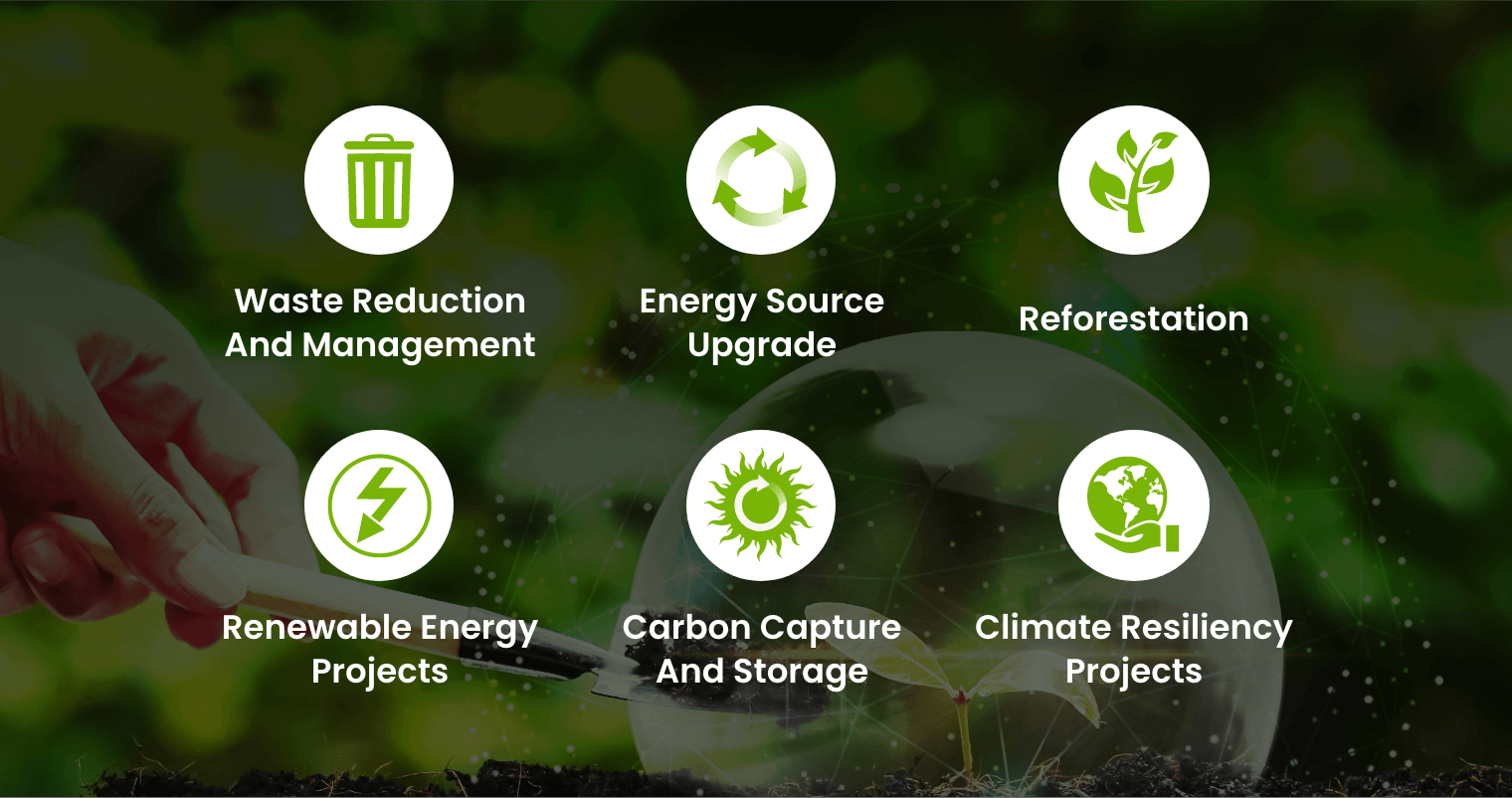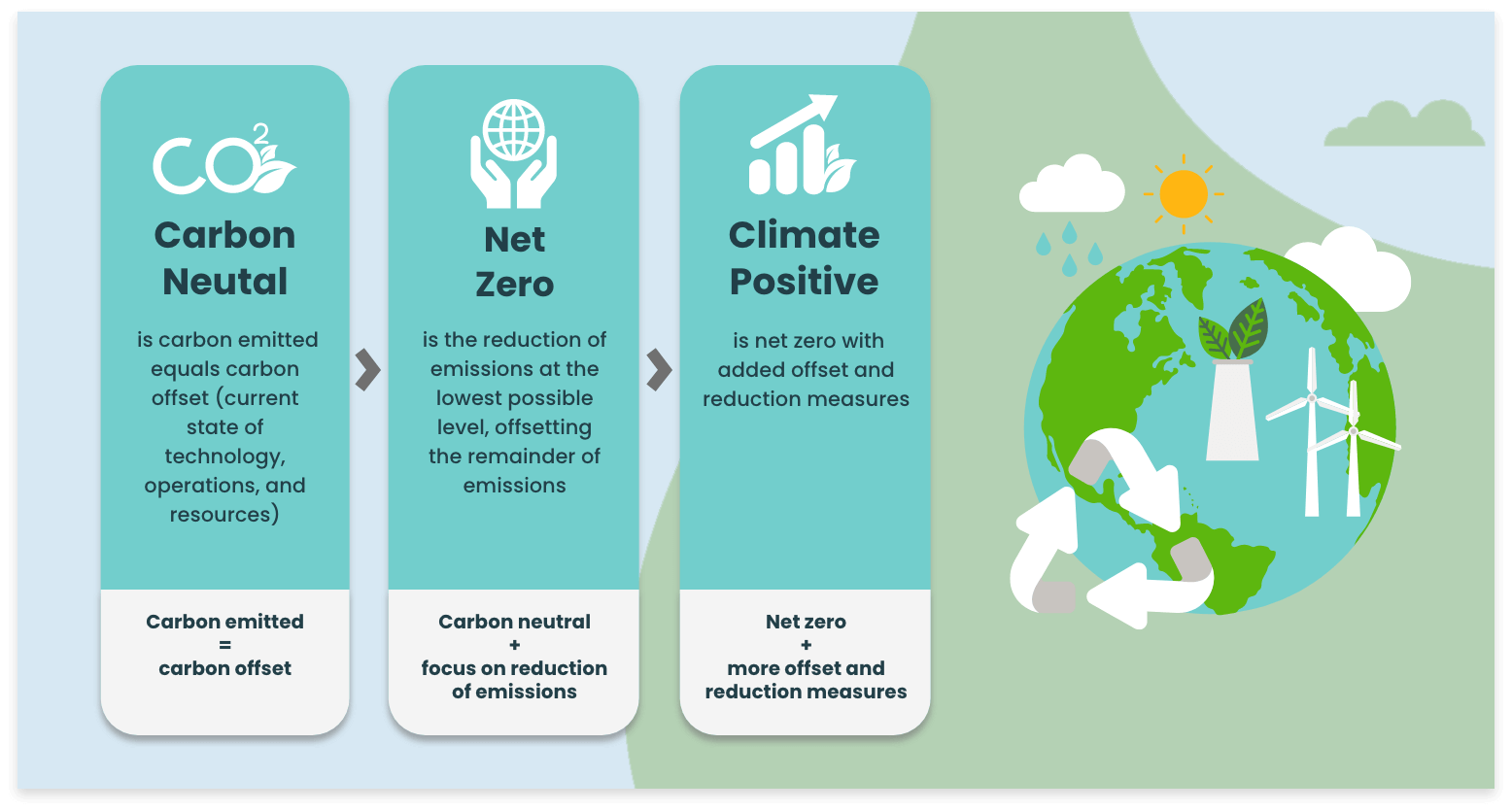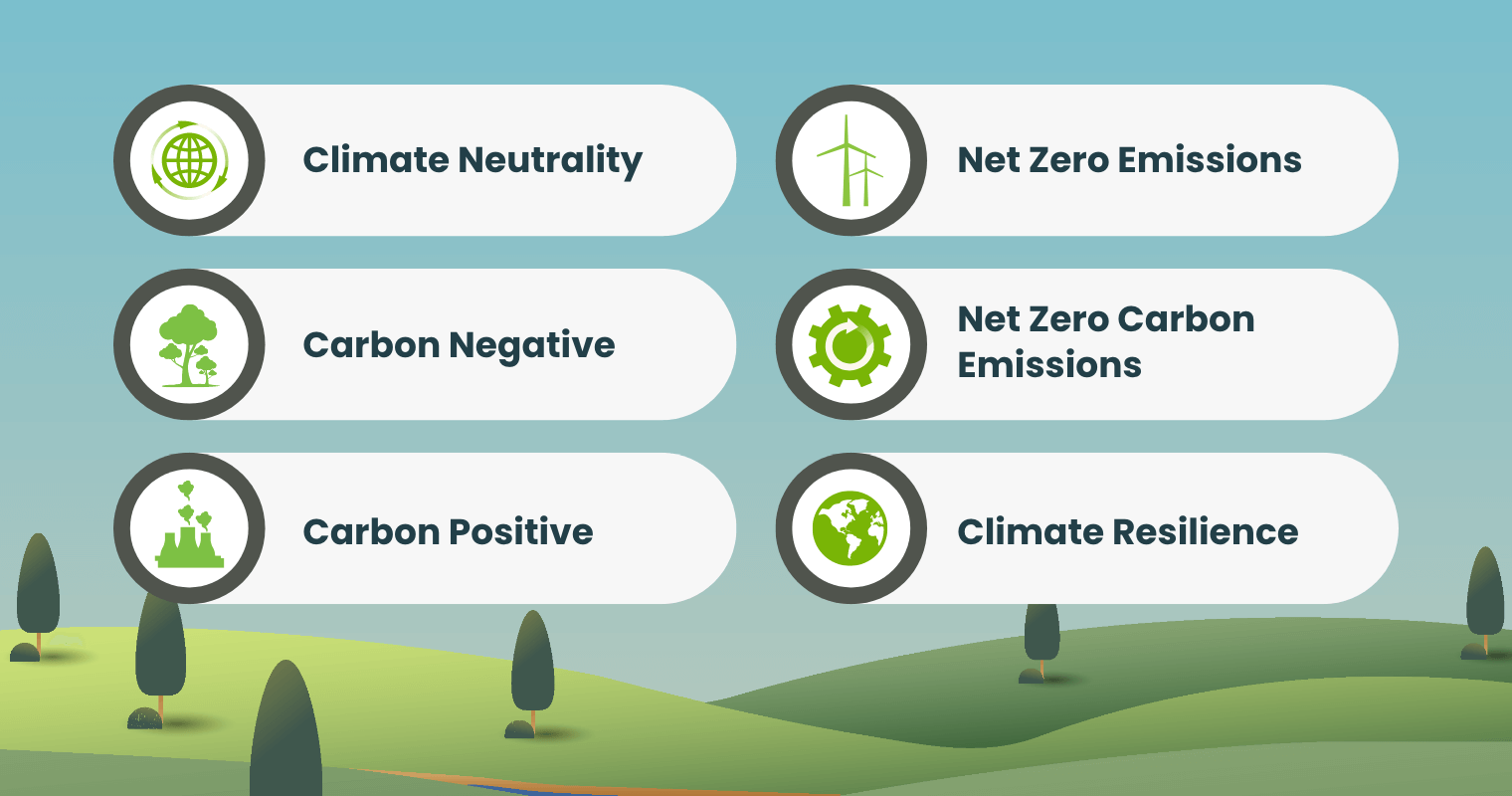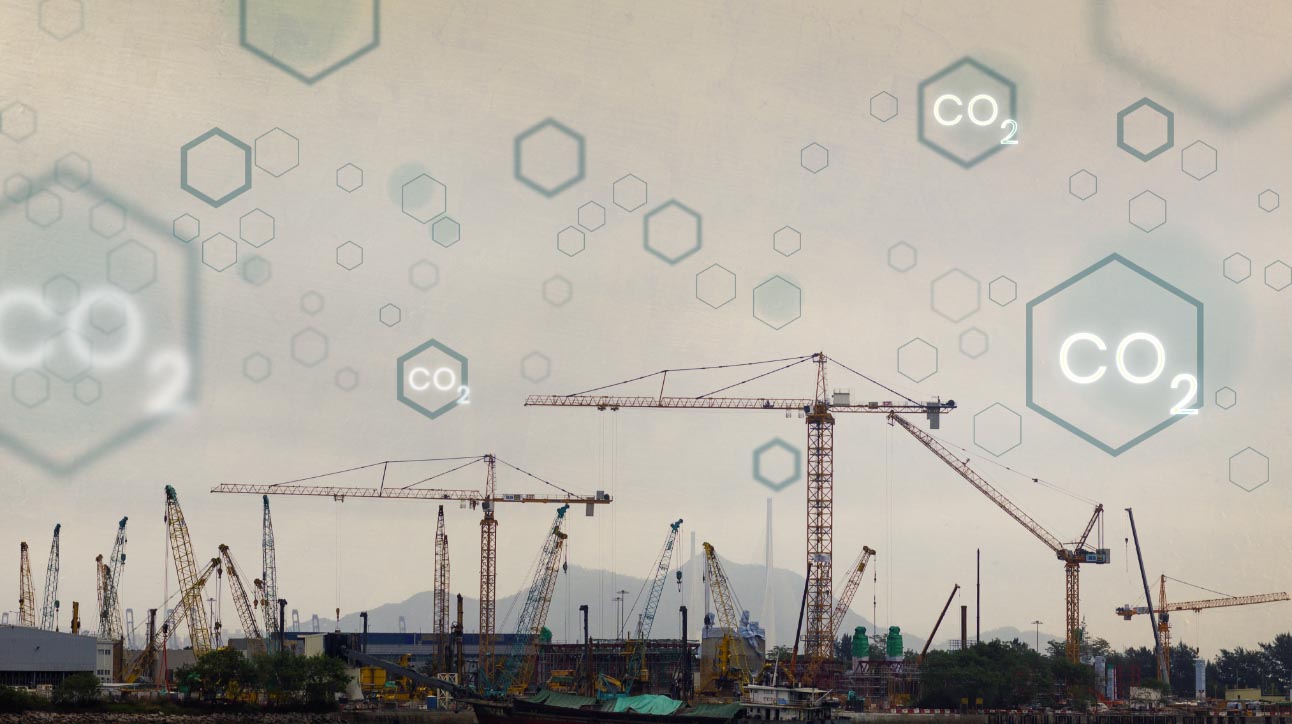As we become more aware of our impact on the planet, sustainability moves to the forefront of corporate priorities. Climate change is an urgent global challenge, and it is crucial to understand how greenhouse gases (GHGs) contribute to environmental harm.
Many countries have stepped up, making significant commitments to tackle GHG emissions. The Paris Agreement, signed by 195 parties, aims to limit global warming to 1.5 degrees Celsius, while the Kyoto Protocol pushes industrialised countries to set specific targets for reducing their emissions. Together, these efforts highlight the importance of collective action in creating a sustainable future.
To effectively contribute to these global initiatives, it helps to familiarise and understand the approaches – carbon neutrality, net zero, and climate positivity – businesses and nations are adopting to reduce their environmental impact. Let’s take a closer look at them.
Path to Climate Positivity: From Carbon Neutral to Net Zero
As we strive to address climate change, we are responsible for being informed of the key concepts that shape our continuous mitigating efforts. You may have come across these keywords in discussions, especially regarding the environmental impact of human activities.
Carbon neutral, net zero, and climate positive are concepts closely tied to strategies for GHG management. To better understand these three, one must look at how their approaches progress and the level of commitment and effort increasing toward achieving a negative carbon footprint.
What is carbon neutrality?
Carbon neutrality is often the starting point in a company’s sustainability efforts. But what does carbon neutral mean? It is when an organisation offsets or compensates for its carbon emissions through equivalent actions, such as reducing emissions or investing in carbon offset projects.
The first step is to assess and monitor the organisation’s carbon emissions. A critical framework that can be used for this is the Greenhouse Gas Protocol (GHG Protocol). Given this, emissions can include direct emissions — those that come from the company’s operations, such as energy use, infrastructure, and transportation. There are also indirect emissions — those generated from energy use, third-party suppliers, or other external entities the company relies on. Emissions from the supply chain on production and transportation are also factored in.
Through carbon accounting, the data gathered is calculated to determine a company’s total emissions for its investment in offsetting measures. These could include supporting reforestation, renewable energy projects, or purchasing carbon credits.
The idea is to balance the amount of carbon emitted with an equivalent reduction elsewhere, thereby balancing the overall emissions produced and offset.
Carbon Offsetting Programs for Your Organisation
Several platforms and organisations can offer carbon credits, such as certified emission reductions or CERs to individuals, businesses, or organisations to offset their emissions based on their impact and sustainability goals. When you purchase CERs, you work toward carbon neutrality and help fund future green projects that promote sustainable development in local communities.
Here are other effective carbon-neutral examples that your organisation can consider.

- Waste reduction and management: Supporting programs that reduce waste and promoting recycling or composting can significantly cut methane emissions from landfills.
- Energy source upgrade: Improving and providing energy-efficient processes and technologies in the organisation and among partners will reduce energy consumption and carbon footprint.
- Reforestation: Investing in local or global tree-planting projects will help absorb carbon dioxide, restore habitat, and enhance biodiversity and environmental health.
- Renewable energy projects: Supporting and investing in solar, wind, hydroelectric projects, and renewable energy sources can help create a less dependence on fossil fuels and decrease overall carbon emissions.
- Carbon capture and storage: Companies that develop carbon capture technologies can be invested in or partnered with to remove carbon dioxide directly from industrial processes and the atmosphere.
- Climate resiliency projects: Supporting projects that enhance community resilience and climate impacts, such as sustainable water management initiatives, can improve land management.
By engaging in these initiatives, your organisation can significantly contribute to carbon reduction and impact the broader environmental and social goals.
What is net zero?
Net zero is a climate action and sustainability idea that focuses on the reduction of emissions first and foremost before resorting to offsetting measures. This means cutting emissions at their source to the lowest possible level. Net zero is a step above carbon neutrality as it pushes for reducing dependence on offsetting measures rather than simply relying on balancing out what is emitted by offset efforts, as is the case with the latter.
The goal of net zero is to cut down all GHGs, however possible, reaching a point where no more GHGs are added to the atmosphere than are being removed. This makes it a broader approach to tackling climate change.
In minimal cases where eliminating emissions is hardly feasible, as in certain essential business activities and operations, companies must work to offset them by investing in certified carbon removal or reduction initiatives, balancing out the remaining unavoidable emissions. This means organisations must implement strategies moving forward toward clean and renewable energy sources and energy use and committing to environmentally responsible practices.
Carbon neutral vs Net Zero: What is the difference?
The key differences between the two are the efforts acted upon and the steps taken first and for the most of the process. Carbon neutrality does not mainly require transitioning to renewable energy sources and sustainable practices, but calls for measures to make up for the emissions because of it. Net zero, on the other hand, involves adopting sustainable carbon zero technologies and practices, making sure emissions are reduced, if not completely, at the lowest possible level.
Carbon Neutral and Net Zero Standards and Certifications
Certifications, standards, and protocols for carbon-neutral and net zero efforts provide a clear framework for measuring, reducing, and offsetting emissions. They help validate companies, ensure environmental goals are met, and build stakeholder trust. These guidelines keep businesses on track and aligned with the global climate goals.
- GHG Protocol: This offers the most commonly used guidelines for counting greenhouse gas emissions. These guidelines categorise emissions into three distinct scopes for better management and reporting:
- Scope 1 emissions are recognised as direct emissions that come from owned or controlled sources by the organisation, such as facilities and vehicles.
- Scope 2 emissions consist of indirect emissions linked to the energy purchased by the organisation, primarily including electricity, heating, and cooling.
- Scope 3 emissions capture all other indirect emissions associated with the organisation’s supply chain. This encompasses activities not directly managed by the organisation, such as waste disposal, employee travel, and the use of products sold.
- PAS 2060: a standard that certifies an organisation’s carbon neutrality, proving that it has successfully reduced or offset its carbon emissions. It offers a straightforward way for businesses to showcase their commitment to sustainability, whether for specific activities, products, or projects. This will be replaced by ISO 14068-1:2023 at the start of 2025.
- ISO 14000 series: a set of international standards that help organisations improve performance on the environmental management system or EMS by creating policies, assessing impacts, setting goals, and implementing programs. A few of the key standards include:
- ISO 14001: Guides organisations in managing environmental responsibilities for sustainability.
- ISO 14007: Helps quantify environmental costs and benefits.
- ISO 14016: Ensures reliability of environmental reports.
- ISO 14050: Defines key environmental management terms.
- ISO 14068-1: Provides guidelines for achieving carbon neutrality and transitioning to net zero emissions.
What is climate positivity?
Climate positivity is the ultimate goal beyond achieving both carbon neutrality and net zero. It means balancing emissions and further removing more GHGs from the atmosphere than are being produced.
Climate positivity goes beyond meeting emission targets and covers a larger scale of sustainability efforts. It builds on net zero practices—addressing all types of GHGs— and then pushes organisations to cut emissions even more. Instead of reducing emissions to zero and merely preventing climate change damage, the agenda of this concept is to reverse it. This move contributes further to the repair and recovery of the planet. For example, companies might invest in large-scale reforestation efforts or new technologies that absorb carbon from the atmosphere, apart from the reduction and offsetting measures already implemented.
In summary, carbon neutral, net zero, and climate positive represent progressively ambitious steps in addressing environmental responsibility. While the first one focuses on offsetting emissions, the second demands a much more significant reduction in all GHGs, and the third goes even further by eliminating more emissions than are produced. Together, these strategies reflect the evolving commitment of companies toward a more sustainable and responsible future.

Examples of Net Zero and Carbon Neutral Companies
As the push for sustainability continues, companies are also stepping up their commitments. This year, Forbes highlighted companies that focused on reducing GHGs within their operations and across their supply chains and customer base. The rankings are informed by data from Sustainalytics and Morningstar, which consider industry context, management practices, and financial stability. Sustainalytics notes that this year’s Net Zero Leaders list features expanded data on more companies, their investments, and improved sustainability reporting.
- Philip Morris International: The objective of their low–carbon transition plan is to have transparent accounting and display of activities contributing to climate mitigation and adaptation. They plan to shift to 100% renewable electricity use in their operations by 2025 and replace better cigarette alternatives.
- Johnson & Johnson: They signed the UN-backed Race to Zero campaign and they plan to shift to renewable electricity and carbon neutrality into their global operations. They aim to reach net zero emissions across their value chain by 2045.
- Tesla: Constructs factories to reduce waste efficiently, water use, and energy consumption. They source renewable and minimise supply chain emissions through direct collaboration with suppliers. Their 2023 solar efforts produced enough clean energy to supply every Tesla facility, including production, support, research, sales, service, and delivery centres over three times.
However, about 38% of over 3,300 large and mid-cap public companies are not aligned with net zero goals, according to new research from Morningstar Sustainalytics. This misalignment highlights the tightening of global ESG regulations that require a closer look at climate strategies and effective ESG reporting.
Other Fundamental Climate-related Terms

Apart from carbon neutral, net zero, and climate positive, there are other terms related to GHG emissions, sustainability, and environmental responsibility. Understanding these concepts is crucial for businesses and individuals striving to navigate the complexities of the entire climate action effectively.
- Climate neutrality is achieved with carbon neutrality and net zero, wherein the total emissions removed and offset are balanced, resulting in no net impact on the climate.
- Carbon Negative, similar to climate positive, refers to achieving a state of more carbon dioxide removed than what is produced.
- Carbon Positive refers to when the carbon dioxide level is higher than what is being absorbed or eliminated. Simply put, carbon is more than zero.
- Net Zero Emissions pertain to a balance of all GHGs released and removed, including methane and nitrous oxide, contributing to no or zero net increase in emissions.
- Net Zero Carbon Emissions pertains to a balance of carbon emissions released and removed, resulting in zero carbon impact in the atmosphere. In other words, it is net zero emissions but solely focused on carbon emissions.
- Climate Resilience means preparing and taking action to deal with the effects of climate change. It can be done by reducing emissions and adjusting to the changing risks and problems that will continue to happen.
How do companies achieve carbon neutrality and net zero by 2050?
Achieving net zero by 2050 requires a collective effort from governments, businesses, investors, and citizens. Many organisations are participating in the Race to Zero, aiming to halve global emissions by 2030 under the Paris Agreement. However, the 2023 UN Climate Change report shows that action must be taken, as emissions aren’t dropping fast enough, and this decade is crucial.
Governments are called to set stronger policies that promote clean energy investments and sustainable choices for consumers. The UN’s Intergovernmental Panel on Climate Change urges for a 43% emissions reduction by 2030 to prevent temperatures from exceeding 1.5°C and causing severe climate impacts. Energy decisions must be integrated into all national policies — finance, labour, transport, and industry — because energy ministries alone can’t achieve the necessary changes.
For companies and organisations to contribute to this, it will require a solid net zero plan that starts with these efforts.
- Companies should assess their carbon footprint and the potential impacts of climate change on their operations through carbon accounting. This analysis will help them identify necessary changes and establish both short- and long-term goals for a successful net zero strategy.
- Transitioning to sustainable practices and operations such as investing in energy-efficient technology and waste management. Sticking to traditional methods may avoid additional costs but will then lead to higher long-term expenses and missed opportunities for innovation.
- Adapting to a net zero model requires clear guidelines and communication among all stakeholders to monitor and maintain the alignment of sustainability efforts and goals of an organisation. This demands accountability and transparency in ESG reporting, which can be simplified using sustainability reporting software.
Forward Through Your Net Zero Journey with Convene ESG
Understanding and applying ESG principles and criteria are crucial for organisations aiming for carbon neutrality, net zero, and climate positivity.
This is where Convene ESG comes in.

Climate and sustainability goals require companies to measure their performance and act responsibly across environmental, social, and governance dimensions, ensuring their practices align with broader climate objectives. Our ESG reporting software helps businesses stay on top of their emissions and goals while keeping things transparent and compliant with regulations. Its automated data collection and alignment to top industry frameworks and standards make tracking progress seamless and easier than ever. This ensures efforts are responsible and aligned with global environmental targets, allowing businesses to confidently communicate plans and achievements to stakeholders with clarity and ease.
Achieve your net zero goals with us. Schedule a demo of Convene ESG today.














